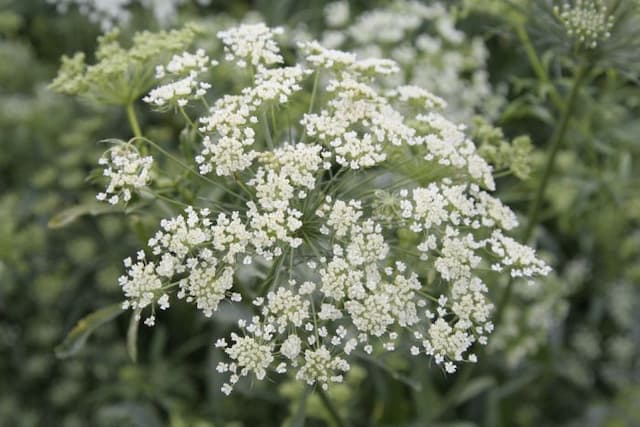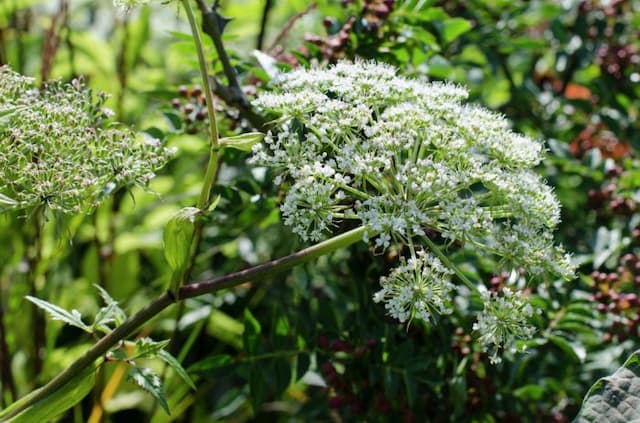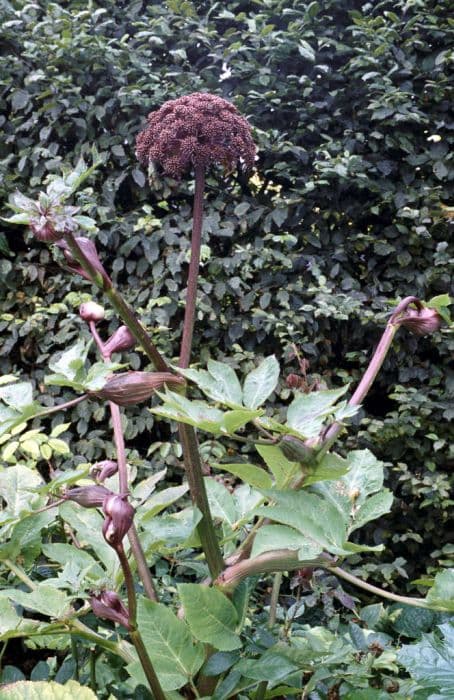Wild carrot Daucus carota 'Dara'

ABOUT
The 'Dara' variety of carrot, commonly known just as carrot or wild carrot, is a particularly striking plant largely due to its beautiful and distinctive flowers. Unlike the common orange carrot, 'Dara' is notable for its airy, lacy flower clusters named umbels. These umbels blossom at the top of the plant in an assortment of colors that range from a soft blush of pale pink to a rich, deep burgundy. The delicate flowers, resembling tiny stars, are assembled into rounded clusters that give an impression of a whimsical, cottage garden look. The foliage of the carrot 'Dara' is feathery and finely dissected, with a bright green color that contrasts beautifully with the bold flowers. These leafy greens create an attractive mound beneath the flower stems, adding texture and volume to the overall appearance. The entire plant gives off an ethereal, wildflower-like charm that can add a touch of whimsy to gardens or cut flower arrangements.
About this plant
 Names
NamesSynonyms
Dara Carrot, Queen Anne's Lace, Ornamental Carrot, Wild Carrot
Common names
Daucus carota.
 Toxicity
ToxicityTo humans
Daucus carota 'Dara', commonly known as wild carrot or Queen Anne's lace, is not considered poisonous to humans. In fact, the domestic carrot that we commonly consume is a cultivar of Daucus carota. However, it is important to note that the wild carrot should not be confused with other similar looking plants such as poison hemlock, which is highly toxic. Ingesting parts of the wild carrot or Queen Anne’s lace typically does not lead to poisoning in humans, and there are no common symptoms associated with poisoning from this plant since it is not toxic. However, always exercise caution and make sure to properly identify plants before ingestion.
To pets
Daucus carota 'Dara', commonly known as wild carrot or Queen Anne's lace, is generally not considered toxic to pets such as dogs and cats. While the plant itself is not poisonous, it may cause mild stomach upset if ingested in large quantities. This is due to the presence of furanocoumarins, which can irritate the digestive system. Nevertheless, it is not known for causing serious or life-threatening symptoms. It is always prudent to monitor your pet and ensure it does not consume large amounts of any non-food plants, as they could potentially cause gastric issues or interfere with their regular diet. If you suspect your pet is reacting adversely to ingesting any part of a plant, consult your veterinarian.
 Characteristics
CharacteristicsLife cycle
Biennials
Foliage type
Deciduous
Color of leaves
Green
Flower color
Varies
Height
3 feet [0.91 meters]
Spread
1 foot [0.30 meters]
Plant type
Herb
Hardiness zones
Varies
Native area
Europe Southwest Asia
Benefits
 General Benefits
General Benefits- Aesthetic Appeal: 'Dara' offers delicate lacy foliage and dainty flowers that range from white to dark purple, adding visual interest to gardens.
- Pollinator Attraction: The flowers of this variety are attractive to bees, butterflies, and other pollinators, thus contributing to the health of your garden ecosystem.
- Edible Parts: Both the leaves and roots of this plant are edible, providing a sweet, carrot-like flavor to a variety of dishes.
- Companion Planting: Known for its ability to pair well with a variety of plants, it can help enhance the growth and flavor of garden vegetables.
- Versatility: This variety can be grown in flower beds, containers, and as a border plant, offering flexibility in garden design.
- Easy to Grow: 'Dara' is considered low-maintenance, making it suitable for gardeners of all skill levels.
- Drought Tolerance: Once established, it can tolerate periods of low water, making it a good choice for xeriscaping and dry climate gardens.
- Cut Flowers: The plant's flowers make for attractive and long-lasting cut flowers, adding beauty to indoor arrangements.
 Medical Properties
Medical Properties- Antioxidant: Daucus carota 'Dara', commonly known as wild carrot or Queen Anne's lace, may contain compounds that exhibit antioxidant properties.
- Diuretic: The plant has traditionally been used for its diuretic effects to help increase the flow of urine.
- Carminative: It helps relieve flatulence and can aid in digestion as a carminative.
 Air-purifying Qualities
Air-purifying QualitiesThis plant is not specifically known for air purifying qualities.
 Other Uses
Other Uses- The flowers of 'carrot' can be used as a dye source for fabrics, providing a range of soft colors depending on the mordant used.
- Some hobbyists use the delicate and ornamental 'carrot' flowers in crafting, such as for making pressed flower artwork or in potpourri mixes.
- Due to its attractive blooms, 'carrot' can be used as a companion plant in vineyards, potentially improving the ecosystem and supporting beneficial insect populations.
- 'Carrot' plants might be used in educational settings, such as school gardens, to demonstrate the life cycle of plants from seed to flower to seed again.
- The seed fluff from 'carrot' can be used as tinder for starting fires in survival situations or traditional fire-making methods.
- 'Carrot' flowers can serve as intricate subjects for photographers and artists looking to capture the beauty of nature in various stages of bloom.
- The plant's ability to accumulate a range of minerals can make 'carrot' useful in bio-monitoring and assessing soil health in particular areas.
- Their long taproots help break up soil and improve its structure, making 'carrot' plants useful in sustainable agricultural practices like crop rotation.
- 'Carrot' foliage can sometimes be used in floral arrangements to provide a unique texture and contrast to other flowers.
- The stems and seed heads of 'carrot' may be utilized in the production of natural brooms or brushes by traditional craftspeople.
Interesting Facts
 Feng Shui
Feng ShuiThe Queen Anne's lace is not used in Feng Shui practice.
 Zodiac Sign Compitability
Zodiac Sign CompitabilityThe Queen Anne's lace is not used in astrology practice.
 Plant Symbolism
Plant Symbolism- Fertility - Carrot flowers, like Daucus carota 'Dara', are often linked to fertility due to their prolific seed production and the fertility of the soil needed to grow a healthy carrot.
- Abundance - The wild carrot, in its capacity to grow vigorously and flourish in various conditions, symbolizes the concept of abundance.
- Purity - The delicate and sometimes white flowers of Daucus carota 'Dara' resemble lace and are associated with themes of purity.
- Humility - Although not a showy or grand plant, the wild carrot represents an appreciation of the simpler things in life and hence signifies humility.
- Connection to the Earth - As a root vegetable, carrots symbolize a deep connection to the earth and grounding energies.
 Water
WaterThe 'Dara' carrot, commonly known as Queen Anne's Lace, should be watered deeply and consistently to maintain moist but not waterlogged soil. During the growing season, water the plant one to two times per week depending on rainfall and temperature, ensuring you provide about one inch of water each week. Water at the base of the plant early in the morning to allow foliage time to dry and reduce the risk of fungal diseases. In hotter periods or if you're growing in containers, you may need to water more frequently. Always adjust your watering routine based on soil moisture, reducing frequency in cooler or rainy periods.
 Light
LightQueen Anne's Lace thrives in full sun conditions, requiring at least six hours of direct sunlight daily. The best spot for this plant would be in an area that receives unfiltered sunlight through most of the day. Although it can tolerate partial shade, too little light may result in weaker stems and less vigorous blooms.
 Temperature
TemperatureFor Queen Anne's Lace, the ideal temperature range is between 60°F and 70°F, which promotes healthy growth and flowering. The plant can survive a temperature range from just below freezing around 25°F, to an upper limit of 85°F, but performance and flowering might be affected outside the optimal range.
 Pruning
PruningPruning Queen Anne's Lace is typically done to remove spent flowers and encourage a second blooming, improve air circulation, or control the plant's size. Deadhead regularly by cutting the spent blooms back to a set of leaves or a new flower bud. If the plant becomes too large or leggy, cut it back by no more than one-third in the late summer to promote denser growth.
 Cleaning
CleaningAs needed
 Soil
SoilThe Queen Anne's Lace 'Dara' thrives best in well-draining soil rich in organic matter with a pH range of 6.0 to 7.0. An ideal soil mix can be created with equal parts of garden soil, compost, and gritty material like perlite to aid drainage.
 Repotting
RepottingQueen Anne's Lace 'Dara', being a biennial, typically doesn’t require repotting as it is usually sown directly outdoors and has a two-year lifecycle.
 Humidity & Misting
Humidity & MistingQueen Anne's Lace 'Dara' is not particularly humidity-sensitive and can adapt to average outdoor humidity levels.
 Suitable locations
Suitable locationsIndoor
Provide full sun and well-draining soil mix for Queen Anne's Lace.
Outdoor
Sow in sunny spot, moderate water, well-draining soil, space 4".
Hardiness zone
3-9 USDA
 Life cycle
Life cycleThe life of 'Queen Anne's lace' 'Dara', a cultivated variety of wild carrot, begins with seed germination, typically occurring in the spring when soil temperatures and moisture levels are suitable for growth. Seedlings emerge and develop into a rosette of finely divided, fern-like leaves during the vegetative stage, focusing on root and foliage development. In its second year, or sometimes late in the first season, the plant transitions to the flowering stage, where it produces tall, branched stems with umbels of attractive pink, white, or deep purple flowers that attract a variety of pollinators. After pollination, these flowers develop into seeds, which mature as the plant senesces. Once the seeds are fully mature, the plant disperses them into the environment, completing its reproductive cycle. The parent plant typically dies after seeding, although in some climates it may biennially survive through a mild winter to flower again.
 Propogation
PropogationPropogation time
Spring to Summer
The 'Dara' carrot, being a cultivar of Daucus carota, is typically propagated through seed. The best time for sowing carrot seeds is in the spring after the last frost when the soil temperature reaches approximately 45 degrees Fahrenheit (7 degrees Celsius). To propagate, seeds are sown directly into well-drained, loose soil at a shallow depth of about a quarter of an inch (6 millimeters). Seedlings will emerge in 2-3 weeks, and thinning may be necessary to ensure proper spacing for root development. Regular watering is essential, especially during germination and early growth stages, but care must be taken not to over-water and to avoid compacting the soil. This direct seeding method is popular due to the carrots' long taproots, which can be damaged during transplanting, making it the most favorable propagation method for healthy growth of 'Dara' carrot plants.









